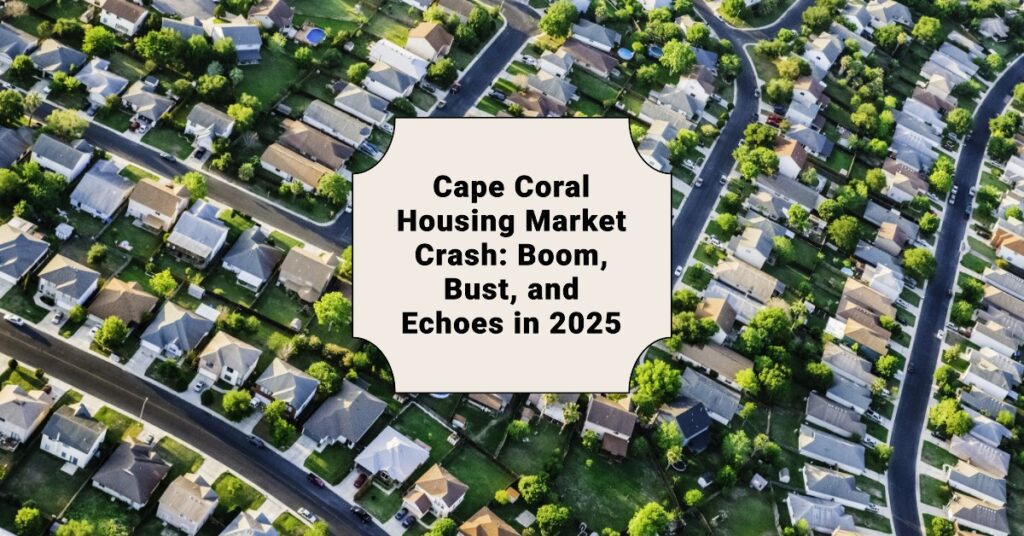Cape Coral’s Real Estate Roller Coaster: Lessons from the Past and Insights for 2025
The Rise of Cape Coral: Economic Boom (2000-2007)
Cape Coral, Florida, famed for its picturesque canal system and waterfront properties, once experienced an exhilarating real estate boom from 2000 to 2007. This period attracted homebuyers from across the nation seeking the sun-kissed lifestyle that Florida promised.
Reasons for the Boom:
- Affordable Housing: Compared to other coastal regions, Cape Coral offered relatively low home prices, attracting first-time buyers and retirees alike.
- Ideal Climate: The warm Florida climate drew seasonal visitors and permanent residents eager to escape colder winters.
- Relaxed Lifestyle: The allure of serene boat rides and fishing trips painted Cape Coral as a dream destination.
According to a report from Duke University, Florida saw a 96% increase in home prices between 2000 and 2007, with Cape Coral likely outpacing this trend.
Market Dynamics:
- Peak Investor Loans: By 2005, investor loans reached a staggering 20% of all mortgages, driven by the belief that home prices would only keep climbing.
- Homeownership Rates: Homeownership peaked at 72% in 2006, only to tumble to 65% by 2014.
The Crash: Ground Zero of the Housing Market (2008)
The once-thriving market came crashing down in 2008 when the subprime mortgage crisis unraveled, marking Cape Coral as a focal point of devastation.
Factors Behind the Collapse:
- Risky Lending Practices: Subprime mortgages flooded the market, often extended to borrowers with poor credit histories.
- Foreclosures on the Rise: More than 40,000 foreclosures occurred in Lee County during 2008, illustrating the extent of the crisis.
Notable Facts:
- Norlarco Credit Union: Known for issuing risky loans, 97% of their construction mortgages were overvalued by around 35%. The credit union’s collapse cost insurers over $10 million.
Aftermath: A Struggle for Recovery (2008-2013)
The years following the crash were bleak. Cape Coral’s housing market faced a slow and painful recovery.
Key Challenges:
- Abandonment: Properties decayed as many homes sat vacant and were often stripped for scrap or invaded by squatters.
- Declining Economy: Businesses shuttered, leading to rising unemployment. The delinquency rate skyrocketed from 1.1% in 2006 to 20% in early 2010.
Key Metrics:
- Cash buyers dominated the market, indicating a lack of confidence among average consumers.
Recovery Phase: A Glimmer of Hope (2013-Present)
By 2013, signs of recovery began to emerge. First-time homebuyers cautiously re-entered the market, and gradual price increases were noted.
Recovery Highlights:
- Median Home Price: By 2017, the median home price in Lee County reached $243,500—a 7.1% increase from the previous year.
- Declining Foreclosures: Foreclosure rates dropped approximately 93% from their peak levels by 2016.
Cape Coral in 2025: An Echo of 2008?
As of May 2025, Cape Coral’s housing market shows troubling similarities to the pre-crash environment of 2008.
Current Market Snapshot:
- Falling Home Prices: Home prices decreased by 7.7% year-over-year, with the median price around $361,000.
- Stagnant Sales: Home sales dipped by 5.7%, as only 608 properties were sold.
- Increased Days on Market: Homes now stay on the market for an average of 76 days, compared to 59 the previous year.
The Underlying Causes:
- Elevated Mortgage Rates: With rates hovering around 6.94%, affordability remains a concern for many potential buyers.
- Economic Uncertainty: Worries about inflation and global factors contribute to buyer hesitancy.
Comparison: 2008 vs. 2025
While the drivers behind today’s market challenges differ from 2008’s fraudulent practices, the current environment is plagued by inventory excess and economic instability.
Expert Insights and Predictions
According to Dr. Selma Hepp, the housing market in Cape Coral faces significant headwinds. While the national growth rate is around 2.0%, Cape Coral has experienced a -6.5% shift.
Realtors emphasize that sellers must adopt a realistic approach to pricing amid these market dynamics.
Conclusion: Lessons for the Future
The dramatic rise and fall of Cape Coral’s housing market serves as a cautionary tale. As the area navigates potential pitfalls in 2025, it underscores the importance of prudent lending practices and realistic expectations within the real estate sector. The community’s resilience will ultimately be tested once again, but lessons from the past may pave the way for a more sustainable future.
For further information about real estate investments in Florida’s most promising areas, consider exploring this real estate guide. Take the first steps towards expanding your investment portfolio with confidence.


